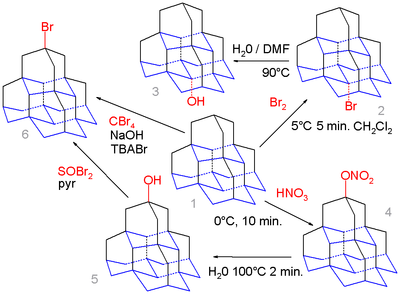Diamantoide: diferenças entre revisões
← nova página: {{tradução}} Um '''diamantóide''', no contexto da fabriação de componentes materiais para nanotecnologia, geralmente refere-se a estruturas que se assemelha... |
(Sem diferenças)
|
Revisão das 01h47min de 22 de maio de 2007
| Parte ou a integralidade do conteúdo desta página resulta da tradução de uma página originalmente presente numa Wikipédia noutra língua. A página correspondente pode ser conferida aqui. As fontes não foram verificadas. |
Um diamantóide, no contexto da fabriação de componentes materiais para nanotecnologia, geralmente refere-se a estruturas que se assemelham ao diamante num sentido amplo.
A diamondoid, in the context of building materials for nanotechnology components, most generally refers to structures that resemble diamond in a broad sense: namely, strong, stiff structures containing dense, 3-D networks of covalent bonds, formed chiefly from first and second row atoms with a valence of three or more. Examples of diamondoid structures would include crystalline diamond, sapphire, and other stiff structures similar to diamond but with various atom substitutions which might include N, O, Si, S, and so forth. Graphite consisting of carbon atoms arranged in planar sheets ("graphene" sheets), carbon nanotubes consisting of sheets of carbon atoms rolled into tubes, spherical buckyballs and other graphene structures are sometimes also included in the class of diamondoid materials for nanotechnology.
Chemistry
In the context of classical chemistry, "diamondoid" refers to variants of the carbon cage molecule known as adamantane (C10H16), the smallest unit cage structure of the diamond crystal lattice. Diamondoids also known as nanodiamonds or condensed adamantanes may include one or more cages (adamantane, diamantane, triamantane, and higher polymantanes) as well as numerous isomeric and structural variants of adamantanes and polymantanes. These diamondoids occur naturally in petroleum deposits and have been extracted and purified into large pure crystals of polymantane molecules having more than a dozen adamantane cages per molecule [1]. These species are of interest as molecular approximations of the cubic diamond framework, terminated with C-H bonds. Cyclohexamantane may be thought of as a nanometer-sized diamond of approximately 2.8 * 10-21 carats. [2]

Examples include:
- Adamantane (C10H16)
- Iceane (C12H18)
- BC-8 (C14H20)
- Diamantane (C14H20) also diadamantane, two face-fused cages
- Triamantane (C18H24), also triadamantane. Diamantane has 4 identical faces available for anchoring a new C4H4 unit.
- Isotetramantane (C22H28). Triamantane has 8 faces on to which a new C4H4 unit can be added resulting in 4 isomers. One of these isomers displays a helical twist and is therefore prochiral. The P and M enantiomers have been separated.
- Pentamantane has 9 isomers with chemical formula C26H32 and one more pentamantane exists with chemical formula C25H30
- Cyclohexamantane (C26H30)
- Super-adamantane (C35H36)
- Basic beryllium acetate Be4O(O2CCH3)6
One tetramantane isomer is the largest ever diamondoid prepared by organic synthesis. The first ever isolation of a wide range of diamondoids from petroleum took place in the following steps [1]: a vacuum distillation above 345°C, the equivalent atmospheric boiling point, then pyrolysis at 400 to 450°C in order to remove all non-diamondoid compounds [3] and then a series of HPLC separation techniques.
In one study a tetramantane compound is fitted with thiol groups at the bridgehead positions [4]. This allows their anchorage to a gold surface and formation of self-assembled monolayers (diamond-on-gold).
Organic chemistry of diamondoids even extends to pentamantane [5]. The medial position (base) in this molecule is calculated to yield a more favorable carbocation than the apical position (top) and simple bromination of pentamane 1 with bromine exclusively gives the medial bromo derivative 2 which on hydrolysis in water / DMF forms the alcohol 3.

In contrast nitroxylation of 1 with nitric acid gives the apical nitrate 4 as an intermediate which is hydrolyzed to the apical alcohol 5 due to the higher steric demand of the active electrophilic NO2 - HNO3+ species. This alcohol can react with thionyl bromide to the bromide 6 and in a series of steps (not shown) to the corresponding thiol. Pentamantane can also react with tetrabromomethane and tetra-n-butylammonium Bromide (TBABr) in a free radical reaction to the bromide but without selectivity.
Origem e ocorrência dos diamantóides
Os diamantóides são encontrados nos hidrocarbonetos (petróleo e gás natural). Os condesados, que são óleos (petróleo) extremamente leves, possuem cerca de uma colher de sopa de diamantóides por galão (cerca de 3,78 litros). Ainda não se conhece a termodinâmica das moléculas de diamantóides, porém seu aspecto cristalino similar ao diamante faz supor origem no interior do manto terrestre. Os diamantóides podem ser carreados junto com os hidrocarbonetos que ascendem do manto para a crosta terrestre nos processos de migração depetróleo e ou gás natural.
Ver também
Link externos
- http://www.physik.tu-berlin.de/cluster/diamondoids.html
- Molecular Diamond Technologies, Chevron Texaco
- Nanotechnology and the arrival of the Diamond Age
Referências
- ↑ a b Isolation and Structure of Higher Diamondoids, Nanometer-Sized Diamond Molecules J. E. Dahl, S. G. Liu, and R. M. K. Carlson Science 3 January 2003 299: 96-99; published online 29 November 2002 Abstract
- ↑ J. E. P. Dahl, J. M. Moldowan, T. M. Peakman, J. C. Clardy, E. Lobkovsky, M. M. Olmstead, P. W. May, T. J. Davis, J. W. Steeds, K. E. Peters, A. Pepper, A. Ekuan, R. M. K. Carlson (2003). «Isolation and Structural Proof of the Large Diamond Molecule, Cyclohexamantane (C26H30)». Angewandte Chemie International Edition. 42: 2040-2044. doi:10.1002/anie.200250794
- ↑ Diamondoids are thermodynamically very stable and will survive this pyrolysis
- ↑ Functionalized Nanodiamonds Part 3: Thiolation of Tertiary/Bridgehead Alcohols Boryslav A. Tkachenko, Natalie A. Fokina, Lesya V. Chernish, Jeremy E. P. Dahl, Shenggao Liu, Robert M. K. Carlson, Andrey A. Fokin, and Peter R. Schreiner Org. Lett.; 2006; 8(9) pp 1767 - 1770; (Letter) Graphical abstract
- ↑ Reactivity of [1(2,3)4]Pentamantane (Td-Pentamantane): A Nanoscale Model of Diamond Andrey A. Fokin, Peter R. Schreiner, Natalie A. Fokina, Boryslav A. Tkachenko, Heike Hausmann, Michael Serafin, Jeremy E. P. Dahl, Shenggao Liu, and Robert M. K. Carlson J. Org. Chem.; 2006; 71(22) pp 8532 - 8540; (Article) doi:10.1021/jo061561x
